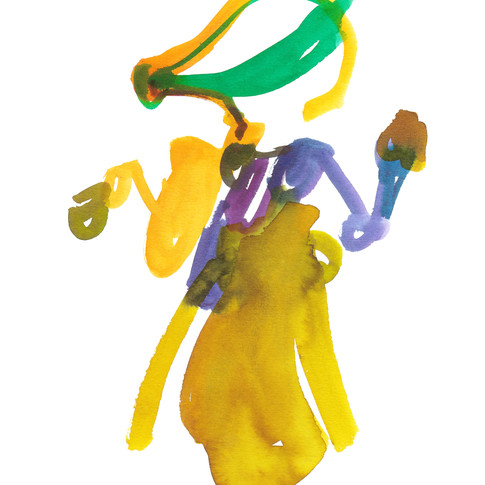THE SQUASH
- Francesco Lo Iacono

- Aug 28, 2018
- 5 min read
Updated: Aug 11, 2021

Over the last months, I have spent some time sketching at the Tate Britain during the dance performance that is part of The Squash, an installation created by artist Anthea Hamilton.
A solo performer in a squash-like costume inhabits the Duveen Galleries every day, for more than six months. Costumes were designed by Anthea Hamilton in collaboration with Loewe's creative director Jonathan Anderson.
I also had the pleasure to meet one of the dancers, the talented Gareth Mole, who also took some time to answer some of my questions about his experience:
Would you like to tell us something about yourself and your journey as a dancer so far?
I began to dance at the age of 6 purely as a mistake and mainly because I was jealous of my sister. After attending classes I started to enjoy moving in such a free way that my parents offered me the choice to start musical theatre and more structured classes. From there, I went to college and completed a BTech National Diploma in Dance and then went on to compete in Line Dancing where I won several world championships.
It was from reaching a top level in this form of dance that I then decided to gain a career out of dance and I then applied to London Contemporary Dance School. Since graduating I have had the honour to work with some amazing companies, touring the world, seeing places and performing iconic work that I had only dreamt of.
How did you first hear about The Squash?
I first heard about The Squash on an audition post online. I was performing in Carmen at The Royal Opera House at the time and thought to myself, I love working in galleries and I knew a lot of wonderful things about Anthea Hamilton so it would be an amazing project to be a part of and to get to work alongside some incredible people.
How was the audition?
Luckily the choreographer at The Royal Opera House allowed me to leave rehearsals to audition for The Squash, so my audition felt a little frantic.
I really enjoyed the audition thought for The Squash. There were around 4-5 people in my audition and the whole thing was improvised. We had a brief structure and got given visual stimulation but from that, we could show the panel how we move as individuals and what we, as artists, could bring to the table for what The Squash could become.
What do you think of the costumes designed by Anthea Hamilton in collaboration with Loewe's Jonathan Anderson?
I adore every single one. Sadly, my torso doesn’t fit into every single piece so I can’t wear them all but my favourite has to be the dress. It offers so much inspiration to you as you offer the ability to make it come alive. It has so much freedom as well as restricting your movement vocabulary at the same time. For example, if I lower to the ground the dress will no doubt get stuck under me, which then only offers me a handful of ways in which I could pick from to exit the floor or move into a different position.
An equal second favourite would have to be the cream knitted one piece. The pattern in it is to die for and I adore the weight of the garment. If you accompany this knitted piece with the orange leather jacket, the whole outfit comes alive with the colours complementing each other and the jacket giving the knitted garment a bit of extra volume and life.
I have spent several days sketching at the Tate Britain during the performance and I think the relationship between the public and the dancer has a huge role in the installation itself...
Each Squash is different. We all have our own different rules and regulations when it comes to interaction with the public. I, for example, have previous knowledge of allowing the audience to interact with the performer in a physical way and how it could open up a larger problem if this happens. So as a rule to myself, I don’t allow myself of the audience to touch the garments of the headpiece, out of respect for the costumes and for myself.
I do, however, create a non-verbal communication by creating The Squash character and how this character would interact with the public, setting out boundaries by creating spatial tension between myself and the audience. I think this is a great way for the audience to understand that I can move freely around this space as it’s my space and they are the guests in the gallery.
During the dance performance, I have seen several children approaching The Squash. Has that happened to you as well?
When children enter the gallery it is one of my favourite things to witness. The automatic confused expression they give off when they see me is amazing. They are trying to work out what type of creature I am.
They understand that I am human but do not understand what type of human. They see limbs, which they identify in themselves but I think it’s the headpiece that throws them of course and adds further to their confusion.
I would say a good 60-70% of children cry upon entering the gallery but I think that those children are merely expressing how the exhibition is making them feel. If only all adults were so capable of allowing themselves to express how they truly felt in public places.
I have had one girl, around the age of 4 I think, who started to follow me around the gallery and then started to copy how I moved. Before I know it, we had engaged in a duet and she copied me and equally I began to copy her.
It felt as if her movement had inspired me to rethink how I would move as a squash. She said goodbye as it was her lunchtime and then returned an hour later with pictures that she had drawn of me.
It was at this moment that I wanted to express to her how much I appreciated her work and how much I adored her for being such a wonderful spirit so I made a little love heart sign with my fingers and gave her a round of applause squash style before moving off to explore another section of the gallery.
What's the best memory of dancing as The Squash so far?
One of my top memories would be the ability to let myself go as a dancer and move freely for hours on end. Rarely you are given such an opportunity to improvise for such a long time.
I often take my breaks in the space at the same time to allow myself some structure in timing so not to exhaust myself, but one of the most satisfying times is when I am dancing, an audience has grown, and I get lost: so lost that time vanishes.
One idea rolls into another and before I know it branches of choreographic stimuli have grown and I could move for what feels like eternity. The gift of moving is one I hold very close to me and one I cherish in this job.





























Comments